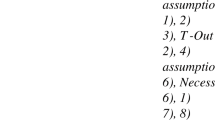Abstract
A bilattice is a structure which can be viewed as a class of truth values that can accommodate incomplete and inconsistent information. In bilattice theory, knowledge are ordered along two dimensions: truth/ falsity and certainty/ uncertainty. Bilattice theory has been applied in areas such as non-monotonic reasoning, truth maintenance systems and more recently to logic programming. In this paper, I will attempt to connect bilattice theory to epistemic logic. In the last decade there has been a resurgence of work on epistemic logic in artificial intelligence. Among them were the logic of implicit and explicit beliefs and the logic of awareness. Most of these approaches attempted to alleviate the problem of logical omniscience. Although these different models have surface dissimilarities, a closer examination shows that they have strong resemblance. Further, given the current proliferation of epistemic logic, it seems prudent to establish comparisons among the various approaches and to consider the issue of unification among them. The main contribution of this research is to show that a uniform framework for reasoning about knowledge can be defined in the context of bilattice theory. This formulation is based on the observation that epistemic notions such as implicit belief, explicit belief and awareness can be associated with subsets of truth values in a bilattice. It is hoped that the proposed work will lead to new insights in both bilattice theory and epistemic logic.
Preview
Unable to display preview. Download preview PDF.
Similar content being viewed by others
References
J. Barwise and J. Perry. Situations and Attitudes. Bradford Books, Cambridge, MA, 1983.
N. D. Jr. Belnap. A Useful Four-valued Logic. In Dunn and Epstein (Eds) Modern Uses of Multiple-valued Logic, pages 8–41. D. Reidel Publishing Company, 1977.
B. Chellas. Modal Logic: An Introduction. Cambridge University Press, 1980.
J. de Kleer. An Assumption-based Truth Maintenance System. Artificial Intelligence 28, pages 127–162, 1986.
R. Fagin and J. Halpern. Belief, Awareness and Limited Reasoning. Artificial Intelligence, 34, pages 39–76, 1988.
M. Fitting. Bilattices and the Semantics of Logic Programming. Journal of Logic Programming, volume 11, number 2, page 91–116, August, 1991.
M. Ginsberg. Readings in Non-monotonic Reasoning. Morgan Kaufmann, Los Alto, CA, 1987.
M. Ginsberg. Multivalued logics: A Uniform Approach to Reasoning in Artificial Intelligence. Computational intelligence 4, pages 265–316, 1988.
J. Halpern and Y. Moses. A Guide to Completeness and Complexity for Modal Logics of Knowledge and Beliefs. Journal of Artificial Intelligence, volume 54, pages 319–379, 1992.
J. Hintikka Knowledge and Belief. Cornell University Press, Ithaca, NY, 1962.
J. Hintikka. Impossible possible worlds vindicated. Journal of Philosophical Logic, 4, pages 475–484, 1975.
S. Kleen. Introduction of Metamathematics. Van Nostrand, 1952.
G. Lakemeyer. Tractable Meta-reasoning in Propositional Logics of Beliefs. International Joint Conference in Artificial Intelligence, pages 402–408, 1987.
H. Levesque. Logic of Implicit and Explicit Belief. In Proceedings of the Seventh International Joint Conference on Artificial Intelligence, pages 389–393, 1986.
J.Lukasiewicz. “On 3-valued Logic”. In S. McCall (Eds) Polish Logic. Oxford University Press, 1967.
N. Rescher. Many-valued Logic. McGraw Hill Book Company, 1969.
K. M. Sim. A Multi-valued Epistemic Logic. Ph.D. dissertation. Knowledge Science Institute, University of Calgary, AB, CANADA, 1994 (to appear).
H. Wangsing. A General Possible Worlds Framework for Reasoning About Knowledge and Belief. Studia Logical 49, pages 523–539, 1990.
Author information
Authors and Affiliations
Editor information
Rights and permissions
Copyright information
© 1994 Springer-Verlag Berlin Heidelberg
About this paper
Cite this paper
Sim, K.M. (1994). Beliefs and bilattices. In: Raś, Z.W., Zemankova, M. (eds) Methodologies for Intelligent Systems. ISMIS 1994. Lecture Notes in Computer Science, vol 869. Springer, Berlin, Heidelberg. https://doi.org/10.1007/3-540-58495-1_59
Download citation
DOI: https://doi.org/10.1007/3-540-58495-1_59
Published:
Publisher Name: Springer, Berlin, Heidelberg
Print ISBN: 978-3-540-58495-7
Online ISBN: 978-3-540-49010-4
eBook Packages: Springer Book Archive




